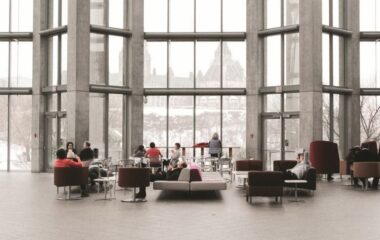Penny Brinsley, Accounts Director at Service Works Global, spoke to FM UK and Tomorrow’s FM about how space management software solutions can help FMs improve workplace management through productivity, collaboration and decision-making.
As the office has transitioned into more of a collaboration space, the way it is used has also changed. With more teams coming to the office to have in‑person meetings, meeting rooms and collaborative spaces have had a boost in popularity. However, it has been found that 27 per cent of meeting room usage is without formal bookings, resulting in 18 million minutes of ad hoc time.
Keeping track of meeting room usage needs an update, especially if office occupancy rises on certain days of the week, as trends are currently showing. Integrating room booking systems and space management software have been popular new additions to the FM’s toolkit to avoid the impending office drama.
Space Management Software
Comprehensive space management software enables FM’s to view the space they manage, its current layout and the location of assets and equipment. It allows them to model “what‑if” scenarios to assess alternative layouts and how they could potentially improve workplace productivity and team interaction.
When combined with a computer‑aided facilities management (CAFM) system including feeds from sensors (which can be located under desks, or in meeting rooms), the software can identify which areas of an office are used the most or the least, and when spaces are in peak demand. Strategic decisions can be made for the workplace based on this data. For example, if the sensors show that one office area is rarely used, this can help inform the case for potential downsizing – not to mention asset and energy management strategies.
On the other hand, if the data identifies a particular meeting room with heavy footfall throughout the week, FM’s can adapt their cleaning schedules to ensure the meeting space is kept to a high standard and that assets in the space are maintained to the highest working order.
As the workplace continues to adapt to the needs and wants of workers, space management software can help with the changing nature of the office. If employees request more collaborative workspaces, for example, FM’s can create a digital map of how the workspace can be organised to suit these needs. This reduces unnecessary work from on‑site teams, as they only need to rearrange the space once as per the design.
Room Bookings
Having a room booking platform is another way to enable better workplace management. Busy office rooms require excellent scheduling to ensure everyone’s meetings go to plan. For example, operations or cleaning teams can advise FM’s how quickly meeting rooms can be turned around between slots. This information can be used to manage better booking schedules, including set up and turn around cleaning times integrated within the booking.
You can also include added extras to create a seamless system. For example, if technical support is needed or catering is required, these additional requests can be added to the booking. Services and catering can be cross‑charged to other departments or third parties who are hiring the meeting space.
Visitor Management
To create the best workplace experience, and support health, safety and security strategies, visitor management is also a top priority. Room booking software can be expanded to incorporate visitor management capabilities, supported by wayfinding in larger facilities.
When an employee books a meeting space, they can indicate who is attending the meeting, including external visitors. This informs the front‑of‑house team who is coming, at what time, and who they are meeting with. Many businesses choose to integrate visitor booking technology with self‑service screens, whereby a visitor easily can check in upon arrival, via a touch screen, and check out upon departure.
The use of space and bookings management software can help FM’s deliver great workplace experiences, especially when integrated with newer technologies, such as sensors. It allows businesses to quickly adapt to new ways of working, ensures maximum productivity, fosters collaboration and provides insightful data about the use of the space, informing better decision‑making.








